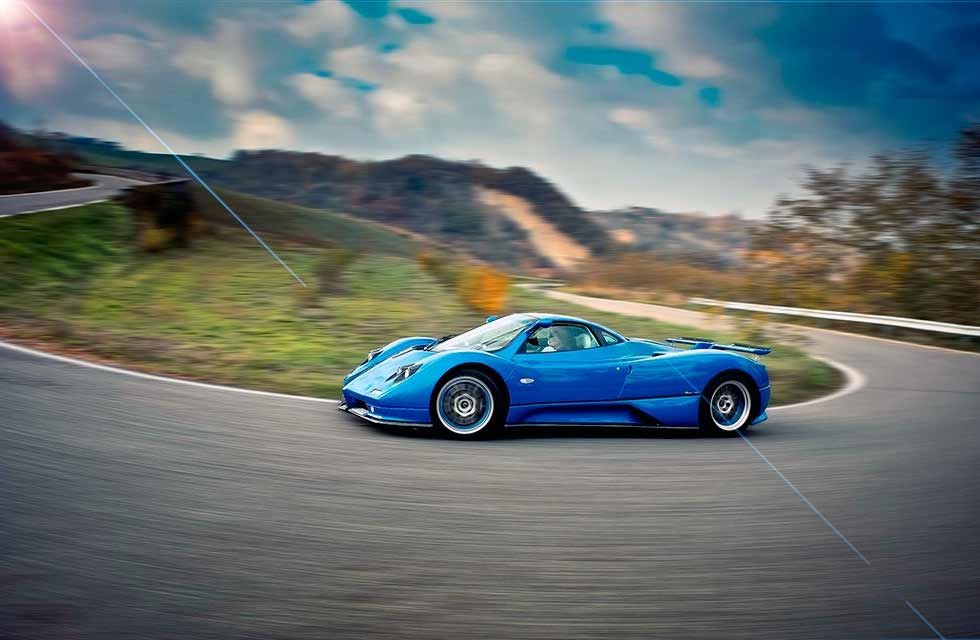
Blown Away Named after a wind, the Pagani Zonda ranks alongside the greats April 2012. The Pagani Zonda was designed more than 20 years ago, yet will still blow away many an established supercar. Alastair Clements drives it in Modena, and meets its charismatic creator. Photography Malcolm Griffiths.
Wind of change

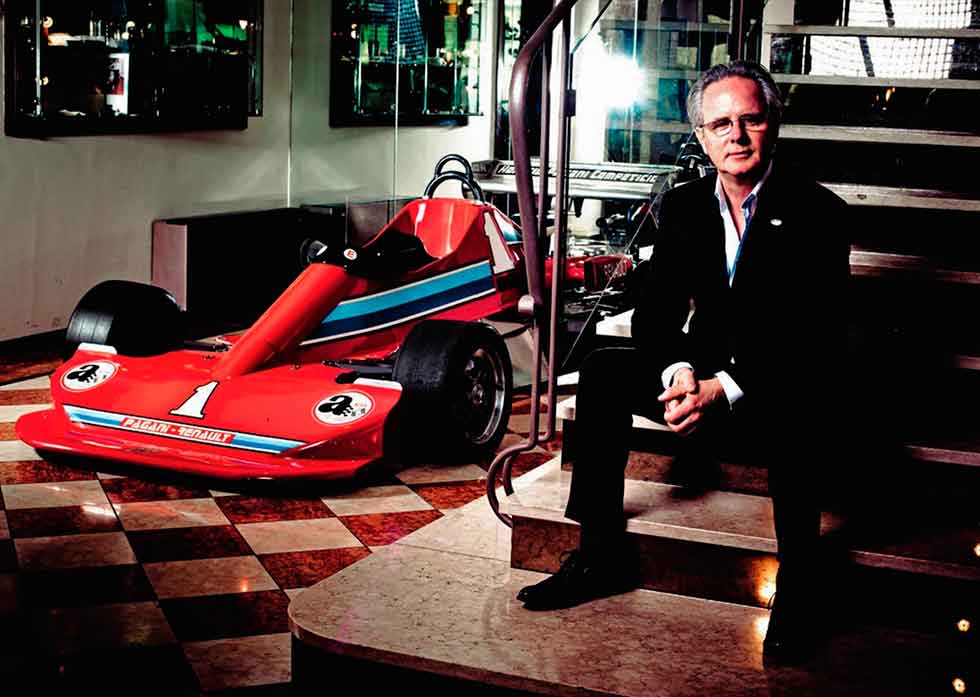
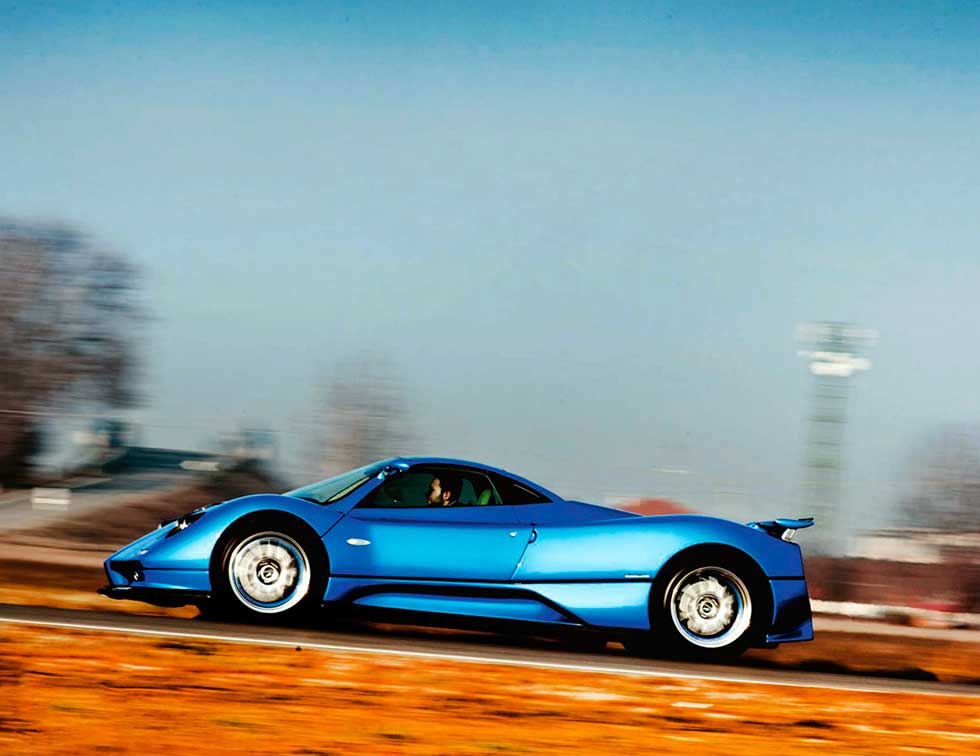
Below, l-r: massive drilled rotors behind 18in alloys; AMG-tuned quad-cam V12.
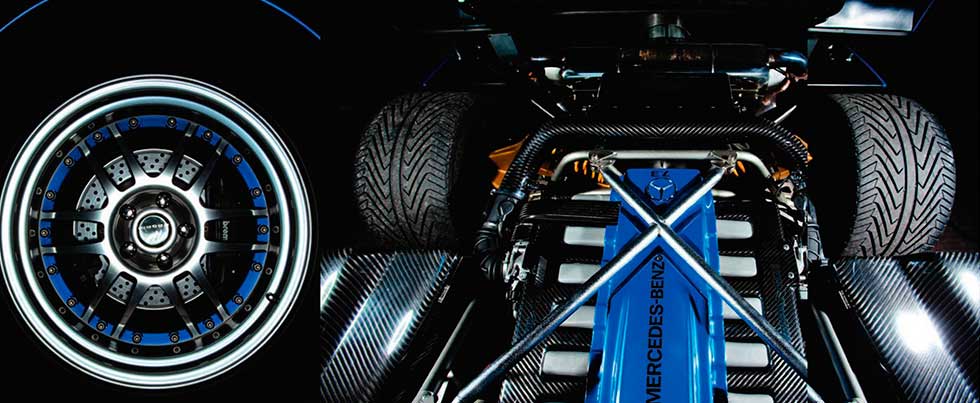
Breaking into a new market is one of the toughest challenges an automotive manufacturer can face. It has taken the Korean car-makers three decades to gain some kind of grudging acceptance in the family-car arena, and just witness the difficulty that Nissan’s sub-brand Infiniti has had in trying to follow Lexus in gaining a foothold in the UK luxury sector against the established German giants. And the magnitude of that task is multiplied when it comes to building a supercar. Any number of names have flourished – however briefly – before falling by the wayside: Spectre, Vector, Venturi, Cizeta, De Tomaso, Ligier, ATS, AMX, Panther – the list goes on. Even the mighty BMW found the transition from supersaloons to a mid-engined hypercar such hard going that it never replaced the slow-selling M1 E26. And that’s from a firm with a huge weight of heritage behind it: what if you’ve never even made a car before?
Which makes the achievements of a certain Horacio Pagani all the more impressive. In a little over a decade he has forged a name for himself in this near-impossible niche, a name that is now spoken in the same sentences as that of Enzo Ferrari and Ferruccio Lamborghini. And all of this after having created just one car. What a debut! And what a car! The Zonda C12 that appeared – without a pre-show fanfare – at the 1999 Geneva Salon, but whose fundamental outline had been frozen as far back as 1993, was no half-baked concept car. This was no pipedream of a storytelling entrepreneur with the gift of the gab and his head in the clouds. This was a car blessed not with pedigree, perhaps, but with the technology, heady performance – and price-tag – to make even the likes of Ferrari and Lamborghini sit up and take notice.
Beneath the dramatic lines honed in the Dallara wind tunnel were carbonfibre panels clothing a super-light, super-stiff carbon composite monocoque – still cutting-edge stuff more than a decade later. “If you have a very rigid chassis then the suspension works better,” explains Pagani. “When we first presented the Zonda in 1999, it was twice as stiff as any other supercar. Even today, the only car that can beat it is our own Huayra.”
Chrome-moly steel subframes front and rear carried beautiful forged aluminium hubs and wishbones – designed, like every detail in this car, under the watchful eye of its passionate creator. Walk around the factory with him for five minutes and you soon see how hands-on this boss is, tweaking the tiniest detail of his latest model even during production as the first customer car nears completion.
Pagani’s friend and inspiration Juan Manuel Fangio introduced him to Dieter Zetsche, then Mercedes-Benz chief engineer, who agreed to supply the firm’s all-alloy, quad-cam V12 to sit amidships, making the Zonda a 220mph flying machine. For the C12 that meant 5987cc, 450bhp and 436lb ft of torque. For the 2000 Zonda S 7.0 it grew to 7010cc and 555bhp, then came the Zonda Roadster in 2003, the 602bhp Zonda F (F for Fangio) and 650bhp F Clubsport, the 2006 F Roadster and finally, in 2009, the 750bhp Zonda R track-day special and the bonkers 780bhp Cinque and Cinque Roadster road cars.
Any Pagani Zonda is special, a true event to behold, but the unique ‘Blu Francia’ S 7.3 that production test driver Simone Tarozzi is noisily warming up in the courtyard of the Pagani factory on Via dell’Artigianato, San Cesario sul Panaro (Modena), is a particular treat. Built for HRH Prince Mohammed Bin Salman Bin Abdulaziz Alsaud of Saudi Arabia, chassis 20 returned to the works when the Prince upgraded to a Zonda F and has been in Mr Pagani’s personal collection ever since. It was the 2003 Geneva show car and starred in Adrenalina Blu, the legend of Michel Vaillant. It is not a car he is used to letting journalists out in, and this point is reinforced as we sign a disclaimer that makes mention of the fact that the temperature outside is hovering around freezing and the huge 18in Michelin Pilot Sports are the originals.
That means that those tyres have taken this particular Zonda around the Nürburgring in an astonishing 7 mins 32 secs on its way to a new record for homologated production cars. “It’s a great achievement that every record we have taken at the Nürburgring has been set with a standard customer car,” says Pagani. “That’s the way we work. We aim to build a car that is comfortable, but that anyone can drive to the track and be fast. In the world of the extreme supercar, people think you need to be an expert driver, but you don’t need to be Michael Schumacher to drive a Zonda. I want every Pagani to be usable every day, just like a normal car.”
A normal car? I don’t think so, not with those looks. In fact, ‘car’ seems far too mundane a word to describe the steed that the four horsemen of the Apocalypse would surely be riding if they paid us a visit in the 21st century. Ignore for a moment the exquisite detail flourishes, the puncturing of vents and grilles, and concentrate on that cab-forward shape. It’s easy to spot Pagani’s influences, such as the pointed prow and reverse-rake stern that hint at old friend Carlo Riva’s Superaquarama speedboat, or the flashes of Mercedes-Benz W196 streamliner or Porsche 917 langheck. Yet they combine to give a whole that, if not exactly beautiful in the traditional sense, has unrivalled theatre. From those quad central tailpipes to the leather straps that hold down the engine cover, every detail has been designed to delight, to amuse, to thrill. “I see it every day, yet every day it’s a ‘wow’,” says Luca Venturi, our minder for the day. In an age when supercar design is being watered down to appeal to the wider audience of a more affluent worldwide society, the Zonda makes no effort to compromise, with the same visual punch that the Countach offered in the ’70s. You sense that if it saw another supercar in the street, it would give it a wedgy and do a couple of donuts around it before disappearing into the middle distance.
And unless that other supercar was a McLaren F1 or a Veyron, with a pretty handy driver behind the wheel, it would get away with it. Mr Pagani is right, this really is a supercar that you could use every day – one owner has recently topped 100,000km. That revelation comes even as you reverse out of the factory gates, and realise that you can see clearly out of the back of it. The steering – surprisingly low-geared at 3.2 turns lock to lock – is fluid, feelsome and sweetly weighted. The same goes for the Chima six-speed gearbox: a touchy notchy, perhaps, but light and quick, and mated to a clutch that is no more fearsome than that you’d find in, say, a BMW 5 Series. And then there’s the brakes – oh my! Four colossal drilled rotors hugged by massive Brembo calipers. They might well be bettered on a circuit, but on the road their fabulous feel (iron discs rather than carbon-ceramic on these earlier cars) and violent power best even a McLaren F1 as the finest stoppers I’ve ever experienced.
Oh yes, and it’s also pretty quick, too: try 0-60mph in 3.7 secs, 100 in 7.4 and 150 in just 16 secs. When Autocar tested a Zonda S in 2003, only the legendary McLaren had posted a quicker set of times in the magazine’s history. Unlike in so many supercars, however, that outrageous acceleration is completely accessible. There’s so much torque that the car will pick up from 1000rpm in top and just keep on pulling until you lose your bottle – which happens a long time before the car becomes even remotely perturbed. And it’s worth doing that little test, because that way you get to experience the AMG-tuned engine’s full repertoire. Bizarrely, it doesn’t sound much like a V12, more like some deranged, animalistic incarnation of a V8, its howl honed by those four pipes into a unique voice with an unmatched range, from the bellowing rumble at low revs to an almost jet-fighter whoosh as the engine seems to get its second wind past 4000rpm and screams towards the 7000rpm redline, followed by a sonic boom of a pop on the overrun as you lift off. It’s addictive stuff and, thanks to a quirk of the exhaust system, it gets louder and louder as the engine warms up, building like the stormy wind that gave the Zonda its name.
Fortunately, all of that anger is delivered to the road with remarkably little fuss. The old tyres and cold tarmac mean that the traction control is called into action on full-bore charges in second, but those tyres are so wide, and the mechanical grip generated by that super-stiff monocoque and cleverly resolved suspension so mighty, that the car rarely feels troubled by its own potency. Turn in and the 255mm-wide front tyres bite hard into the blacktop and just seem to hang on, even as you feed more power in on the exit, while the 345mm rears will only be shaken by throttle-pedal thuggery. That brilliant inherent balance is also aided by the Pagani’s comparatively low weight. At 1280kg (dry) it’s half a ton lighter than many of its contemporaries, which means that – although it is wide – it feels wieldy even on the tiny Modenese country lanes we’re restricted to today.
That the Pagani corners so well ought not to be a surprise, but the way the car rides the bumps is a revelation. The damping is beautifully resolved, so even big intrusions such as bridge ramps can be tackled at speed without fear, while rutted roads won’t upset its mid-corner composure. The key to that ability, says Pagani, is that he set out not to make a race-car for the road, but a dedicated roadgoing supercar: “Race and road cars are two very different worlds. The biggest mistake you can make is to try to take race technology and put it straight on to the road. The big difference with a road car is that you have to take into account comfort and add bushing, which allows everything to move. The most important thing is to be able to imagine it – it isn’t all about computers.” Likewise with the aerodynamic performance. In a wind tunnel it’s perfectly resolved, but real life isn’t like that: “Yes, the undertray and venturis do produce downforce, but it is dangerous to rely on it. The road is not a billiard table, it is bumpy and upsets the airflow.”
It’s perhaps fortunate that he has created such a user-friendly machine, because it’s all too easy to be distracted by the leather, Alcantara, polished aluminium and carbonfibre of the Zonda’s cabin. Try as you might, you won’t find any parts-bin raiding in here – even the switchgear is bespoke: “My favourite part? The centre-console switches. I saw them on an Alfa 30 or 40 years ago and I tracked down the company that made them so that we could get the same ‘tak-tak’ feel.” Once again there’s the feeling of no constraints, no purse-strings, pure design freedom. Of course that does mean that some bits of it are, well, a little OTT, but this is such a personal project that you have to forgive Horacio the odd indulgence in making his boyhood dreams come true – check out those carbonfibre periscopes that support the central air intakes, or the jewel-like floor-hinged pedalbox. Like so many elements of the Zonda, the latter gem spent years gestating in Pagani’s mind, waiting for a suitable car to give it a home.
The leather and aluminium you take for granted – it’s no more outlandish than, say, a TVR Tuscan, albeit rather better executed – but it’s almost impossible to convey just how beautifully crafted the carbonfibre work is on these cars. In the showroom sits the final Zonda F Roadster, awaiting collection by its owner, which has been painted with transluscent purple paint then lacquered to show off the immaculate weave of the fibres beneath. The stunningly presented engine bay is no less impressive, with its polished luggage bins – in carbonfibre, of course – and that huge V12 flanked by the supremely elegant aluminium suspension componentry, powder-coated in gold.
After 13 years and some 130 cars, the Zonda is gone, and a more bespoke product you’d be hard-pushed to find – no wonder the extreme examples are already changing hands for a million Euros plus. In its place comes the Huayra, a car that puts Pagani at something of a crossroads: in 10 years it has grown from 20 staff to 160, and the new car will ramp up annual production from 18 to 40, in an all-new factory. But any idea that these changes mean a move towards mass production are quickly dismissed: there are the same aeronautical standards, with each hand-made car requiring three books of sign-off sheets for every process in the build.
Forget the area – and the era – and the comparisons seem rather more Molsheim than Modena. Exquisite designs matched to engineering brilliance and assembled with the skills of a traditional carrozzeria – albeit employing the most modern of materials. Never mind the comparisons with Enzo Ferrari or Ferruccio Lamborghini – is Horacio Pagani the Ettore Bugatti of his generation?
Horacio Pagani – the man behind the machine
So who exactly is Horacio Pagani? And how did he make it from baker’s son in Casilda, Argentina to motor manufacturer in Modena, spiritual home of the supercar? “I knew I wanted to build cars when I was very small,” Pagani explains from the glazed office above the Pagani showroom he designed. “For me, building things has always come naturally, so I designed and made slot-cars from balsa when I was 10.” Those models still sit in a glass case in the showroom, as a reminder of the power of self-belief: “When I was 15, I told my mother, ‘When I am older, I will go to Modena and build my own supercar.’”
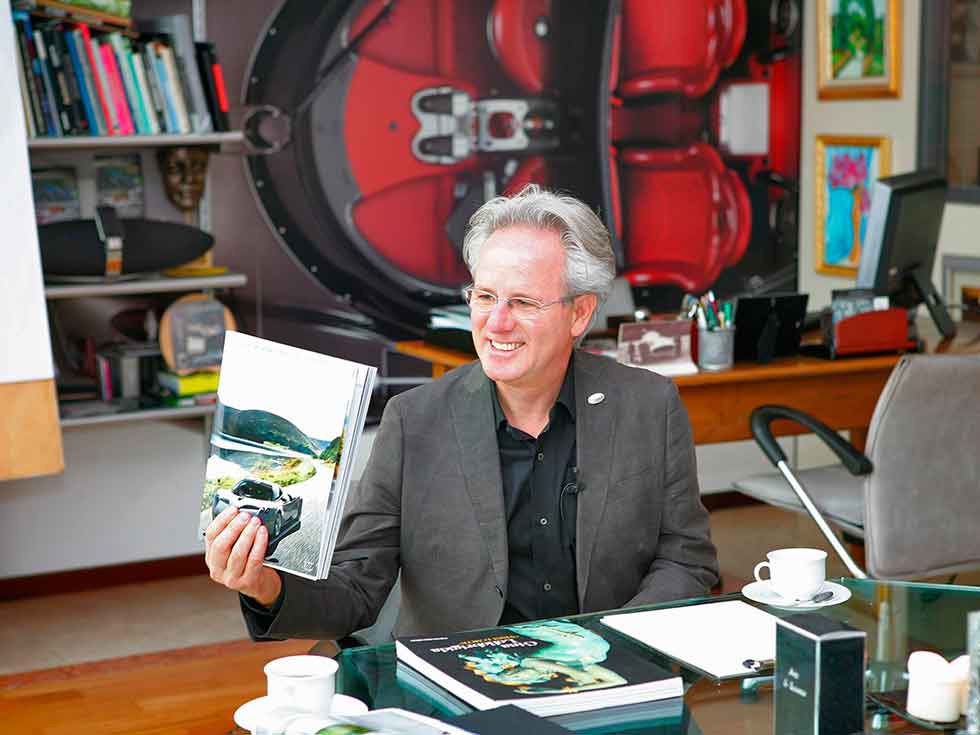
True to his word, Pagani began to teach himself the skills he would need to achieve his dream, restoring motorbikes and enrolling in a course on glassfibre techniques. After building a kit-car from a wrecked Renault Dauphine, at the age of 18 he headed to university to study industrial design. Driven from La Plata by the political turmoil surrounding General Peron’s return, a year later he switched to mechanical engineering in Rosario. But Pagani had always gained more from the university of life. He dropped out and set up a one-man design-and-build business in a shed he nicknamed ‘the factory’, back home in Casilda. As his reputation grew, Pagani graduated from bar benches to caravans, perfecting his glassfibre moulding and technical knowledge before embarking on his most ambitious project yet: a single-seater racing car for Argentinian National Formula 2.
Through competition he met Oreste Berta, and when he told the famed team manager of his dream of working in Italy, Berta suggested he get in touch with Juan Manuel Fangio. “For an Argentinian, Fangio was an icon,” says Pagani. “Berta called him to set up a meeting and I went to the Mercedes headquarters in Buenos Aires where he had an office. You could feel his greatness of character; he was a unique person – pure, sincere, a master of life as well as of cars. I showed him my portfolio and he said: ‘I have written many letters of introduction in my life, but only one letter of recommendation; this is the second.’”
In November 1982, still just 26 years old, Pagani struck out for Italy, the land his great-grandfather had left in search of his fortune nearly a century earlier. In his bag were letters from Fangio to Enzo Ferrari, Alejandro De Tomaso, Giulio Alfieri (Lamborghini), Enzo Osella and Carlo Chiti (Alfa Romeo). Alfieri gave him that longed-for break, and Pagani became an employee of Lamborghini Automobili, starting out as a manual worker in the bodyshop and working his way up to head the fledgling composites department. How was it? “Bellissimo! I was the first in at 6am and I turned out the lights at 8pm – they called me not an employee but an addict. Lamborghini gave me a lot, but I gave all I had back.”
Under Pagani’s stewardship, the deparment created the wild Countach Evoluzione, a stillborn Jalpa replacement and the Countach Anniversary: “The Countach was like a spaceship when it arrived. I can build one up with my eyes closed, I know the design so well, so when I came to do the Anniversary I knew all of its problems and was able to improve build times from 1 to 1.6 cars a day. The hardest thing about redesigning the Countach is that it was born with no bumpers and needed them for the US market. It was 17-years old by then and, as with any girl, we had to add a little make-up to keep her looking young! We were meant to build 170, but sold 670 at Lire240m each to the QV’s Lire170m – it was very good for Lamborghini finances.”
But Pagani was becoming increasingly frustrated by Lamborghini’s refusal to buy an autoclave to further his carbonfibre research. In 1987 he took out a loan, rented a workshop and bought his own. Thus Modena Design was born, a firm that would place itself firmly at the forefront of carbonfibre technology: “It was through the Countach Evoluzione that I came to believe in it as a material. I’ve always been good at working with my hands so I began to develop it from there. Leonardo Da Vinci is my teacher, my master. More than 500 years ago he said that art and science work together, and today this is our motto.”
Various concepts followed for major manufacturers, plus carbonfibre panel supply for the Diablo, but all the time Pagani was working on the Zonda. Sadly, its biggest supporter would not survive to see the car’s show-stopping 1999 Geneva debut: “Every time Fangio came to Italy he came to visit. He was a fountain of inspiration, and for me the Zonda is Fangio in the form of a car – safe, fast, yet easy-going. For the first sketches in 1987-1988 I called it the ‘Fangio F1’, and Fangio told me: ‘If you give a car my name, it has to have a Mercedes engine.’ He followed the whole project until his death in 1995. When he was in Italy, he used to sleep in my kids’ room – you can’t imagine how beautiful it was to see that when you opened the door in the morning!”
Pagani remains remarkably humble about his amazing career: “You need to have the energy and the passion to do what you want, and get up early every day to achieve it, but I was also very lucky. When you find someone who believes, understands and listens to you, you can never repay that. Unfortunately, most people believe the opposite.”
TECHNICAL DATA FILE PAGANI ZONDA C12 S 7.3
Sold/no built 1999-2011/130 (all Zondas)
Construction carbonfibre composite monocoque, chrome-moly steel spaceframes front and rear, carbonfibre panels
Engine mid-mounted, all-alloy, dohc-per-bank 7291cc 48v Mercedes/AMG M120 V12, with electronic sequential fuel injection
Max power 555bhp @ 5900rpm
Max torque 553lb ft @ 4050rpm
Transmission six-speed manual, driving rear wheels via self-locking diff; traction control
Suspension forged-aluminium double wishbones, coil springs, Ohlins adjustable telescopic dampers, anti-roll bar f/r Steering power-assisted TRW rack and pinion
Brakes 14in (355mm) front, 131/4in (335mm) rear ventilated discs, with servo and anti-lock
Wheels & tyres 18in OZ Racing split-rim alloys with 255/40 (f), 345/35 (r) ZR18s
Length 14ft 5in (4395mm)
Width 6ft 9in (2055mm)
Height 3ft 9 ¼ in (1151mm)
Wheelbase 8ft 11 ½ in (2730mm)
Weight 2822lb (1280kg, dry)
0-60mph 3.7 secs
0-100mph 7.4 secs
Top speed 220mph
Mpg 16.9
Price new in UK £298,000






